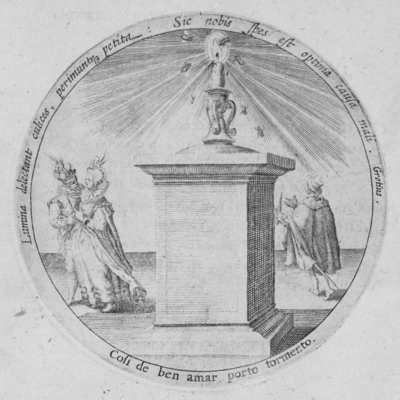Daniël Heinsius, Quaeris quid sit Amor (c. 1601)
Table of contents ↑Cosi de ben amar porto tormento [8]

Den liefelicken schijn van haer twee schoone ooghen
Die trecken my tot haer wanneer zy sich vertooghen/
Vertoogen ah eylaes/ ick schyne my te zijn
Verloren als ick ben van d’oorsaeck van mijn pijn.
By d’oorsaeck van mijn pijn woud’ ick wel altijdt wesen/
Als ick ben by ’tverderf/ zo schijn ick te ghenesen.
Ick vliegh’ rondtom het vier/ ick blijf in eenen standt
Ten zy dat ick my self vind ganschelick verbrandt.
Die trecken my tot haer wanneer zy sich vertooghen/
Vertoogen ah eylaes/ ick schyne my te zijn
Verloren als ick ben van d’oorsaeck van mijn pijn.
By d’oorsaeck van mijn pijn woud’ ick wel altijdt wesen/
Als ick ben by ’tverderf/ zo schijn ick te ghenesen.
Ick vliegh’ rondtom het vier/ ick blijf in eenen standt
Ten zy dat ick my self vind ganschelick verbrandt.


Translations
 |
Zo draag ik de pijn van goed liefhebben. |
 |
Thus I bear the pain of loving well. |
 |
Muggen houden van het licht, maar sterven eraan als ze er naar toe gaan. Zo is onze grootste verwachting de oorzaak van ellende. |
 |
Mosquitos love the light, but die when they approach it. In the same way our greatest hope is the cause of our woe. |
Sources and parallels
- Same emblem in 1608 edition: Cosi de ben amar porto tormento [8]
 (in: Daniël Heinsius, Emblemata amatoria (1607/8)
(in: Daniël Heinsius, Emblemata amatoria (1607/8) )
[Compare
)
[Compare ]
]
- Source for the motto: Petrarca, Canzoniere
 , poem. 207, 79
, poem. 207, 79 - Source for the metaphor of the lover as a moth in the fire: Petrarca, Canzoniere
 , poem. 19 and Petrarca, Canzoniere
, poem. 19 and Petrarca, Canzoniere , poem. 141
, poem. 141 - Source for the motto, pictura and entire emblem: Junius, Emblemata [web]
 , embl. 49
, embl. 49
- Source for the motto and pictura: Giovio, Dialogo dell'imprese
 , pp.
186-187
, pp.
186-187 - Parallel for the motto, pictura and entire emblem: Rollenhagen, Nucleus emblematum selectissimorum
 , bk/embl. I/64
, bk/embl. I/64 - Parallel for the pictura and entire emblem: Rollenhagen, Nucleus emblematum selectissimorum
 , bk/embl.
I/40
, bk/embl.
I/40 -
Parallel in the 1616 edition (motto and subscriptio the same, modified pictura (mirrored, more detailed in the background,
the single
lover walks towards the candle)): Cosi de ben amar porto tormento. [32]
 (in: Daniël Heinsius, Ambacht van Cupido, from: Nederduytsche poemata (1616)
(in: Daniël Heinsius, Ambacht van Cupido, from: Nederduytsche poemata (1616) )
[Compare
)
[Compare ]
]
-
A parallel (and probably adaptation) for the subscriptio and probably entire emblem: Brevis et damnosa voluptas [52]
 (in: Otto Vaenius, Amorum emblemata (1608)
(in: Otto Vaenius, Amorum emblemata (1608) )
[Compare
)
[Compare ]
]
-
Parallel for the entire emblem: main pictorial element the same (mosquitos flying towards a candle) and Latin subscriptio
the same. Brevis & damnosa voluptas [33]
 (in: Otto Vaenius, Emblemata aliquot selectiora amatoria (1618)
(in: Otto Vaenius, Emblemata aliquot selectiora amatoria (1618) )
[Compare
)
[Compare ]
]
References, across this site, to this page:
- Cosi de ben amar porto tormento [8]
 (in: Daniël Heinsius, Emblemata amatoria (1607/8)
(in: Daniël Heinsius, Emblemata amatoria (1607/8) )
)
- Cosi de ben amar porto tormento. [32]
 (in: Daniël Heinsius, Ambacht van Cupido (1613)
(in: Daniël Heinsius, Ambacht van Cupido (1613) )
)
- Cosi de ben amar porto tormento. [32]
 (in: Daniël Heinsius, Ambacht van Cupido, from: Nederduytsche poemata (1616)
(in: Daniël Heinsius, Ambacht van Cupido, from: Nederduytsche poemata (1616) )
)
- Brevis et damnosa voluptas [52]
 (in: Otto Vaenius, Amorum emblemata (1608)
(in: Otto Vaenius, Amorum emblemata (1608) )
)
- Brevis & damnosa voluptas [33]
 (in: Otto Vaenius, Emblemata aliquot selectiora amatoria (1618)
(in: Otto Vaenius, Emblemata aliquot selectiora amatoria (1618) )
)
